#planar handbook
Explore tagged Tumblr posts
Text
Alchemy & Dreams in Beetlejuice Part 2
As mentioned in the last post, red represents Lydia: the material realm & sulphur. The item which falls next to Astrid's cracked photograph is a molecular structure with a red atom and a green atom. It's already common knowledge that Betelgeuse is green-coded, but I have further proof to support the atom theory.
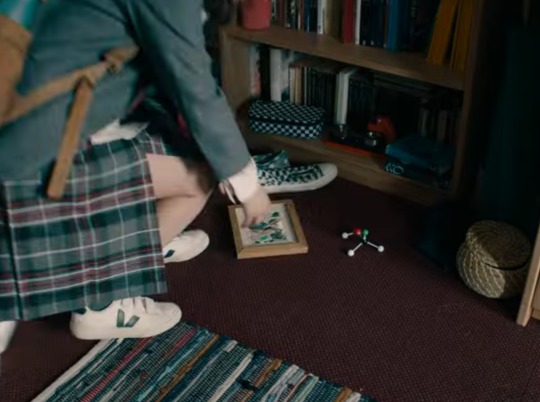
Alchemists viewed the human body (microcosm) as a reflection of the universe (macrocosm). This suggested that atoms could give insights about human nature. Within this context, consider Rosenkreutz illustration of the Chymical Wedding, where the married couple are holding onto the structure. They're supposed to represent two atoms of the same trigonal planar molecule, because they are of the same element, thus sharing a chemical bond.
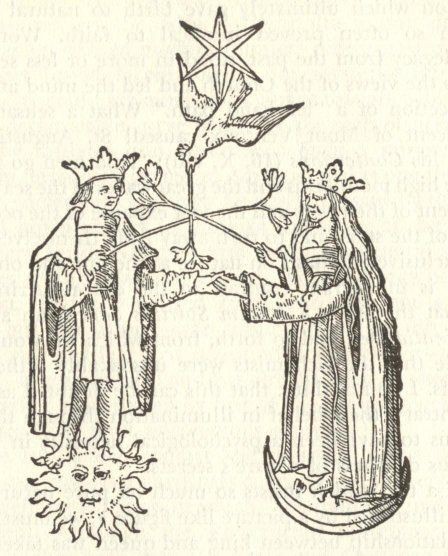
Alchemy consists of a mix of chemistry, philosophy, semiotics, and metaphysics, with much of the symbolism used to convey alchemical themes in Beetlejuice.
Before I come back to this, let's talk about...
Otho
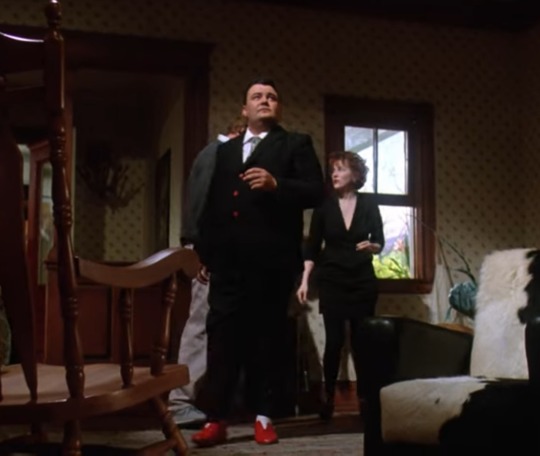
Throughout the first movie, Otho is typically associated with black and red. He's often wearing black with either a red tie, red buttons, or red shoes (which mysteriously disappear in a couple scenes only to be replaced by different colour shoes).
Red shoes have long been used in media to represent a metaphorical journey (The Red Shoes (1948), Kiki's Delivery Service (1989), and Hans Christian Andersen's The Red Shoes are a few examples). Need I remind you of one of Tim Burton's favourite movies, The Wizard of Oz?

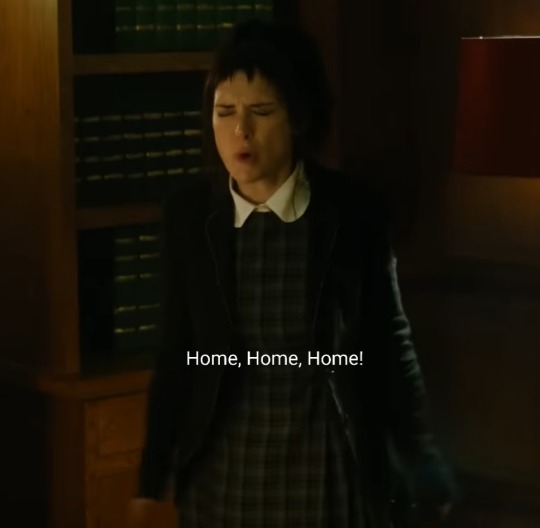
Otho is the only character other than Lydia who piques interest in the dead. Despite his willingness to exploit them, he is ready to believe in their existence and study the handbook. These visual cues are conveying the character's motives.
Part of the alchemical process are the stages "Rubedo" and "Nigredo". Rubedo is Latin for "redness", the stage of understanding where two opposites have joined and created harmony. Nigredo is Latin for "blackness", the stage of putrefaction or decomposition, thus symbolising the dead. In layman's terms, red and black represent the character's willingness to connect with the dead. The only other character really associated with black and red is Lydia, and that speaks for itself.
Otho is a character who inspired the creation of Rory in the second movie. Within Lydia's psyche, Rory has been manifested from guilt. In the first film, Lydia is almost complicit in helping Otho to exorcise the Maitlands after he makes it clear that he wants to capitalise on the dead. In the second film, Lydia is under Rory's management to capitalise on the dead, and she is trying to make peace with that guilt by trying to help people through exorcisms.
Guilt in dreams is often seen as a manifestation of the unconscious mind's attempt to communicate unresolved internal conflicts. This is where the shadow becomes a central concept in Jungian psychology, referring to the parts of the Self that the conscious mind rejects or ignores. Lydia rejects the traits that Otho and Rory embody, and that is why her reconciliation with Astrid is a manifestation of her own forgiveness.
More on The Chemical Wedding
We talked about the purpose of the Chemical Wedding before, but why is it so relevant to the plot of Beetlejuice? Other than the fact Betelgeuse has fallen in love with Lydia, there is an allegorical reason for why the wedding must take place between these two, and no one else but these two.
A Chemical Wedding is the marriage between the sun and the moon. In alchemical texts they are often depicted as the white queen and the red king, though this has nothing to do with literal gender roles, for we see Lydia herself portrayed as the red king in her parallel with Astrid. It is related to the Anima (the female self) and the Animus (the male self). This is also the marriage between mercury and sulfur, spirit and matter, the dead and the living.
One of the most famous works on the subject of a Chemical Wedding is a Rosicrucian allegory published in 1616 by Christian Rosenkreutz. It describes a mystical journey where the main character must attend a wedding at a mysterious castle. The journey is a symbol of the alchemical process, while the wedding itself represents the final transformative stage.
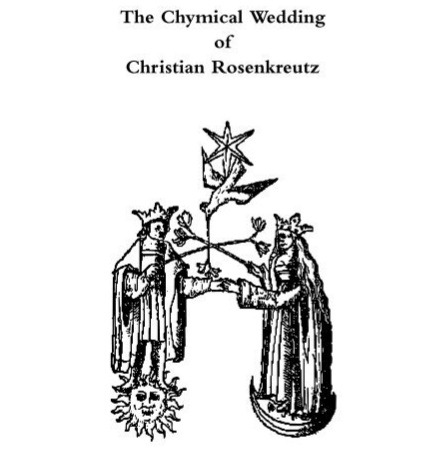
The story is filled with strange and dreamlike imagery, with many claiming it as a source of German dark romanticism.
Rosenkreuz's allegory actually represents inner transformation of the individual, with marriage being used as a metaphor, insofar as the masculine and feminine halves must be merged together in matrimony to achieve completion within oneself.
"Death and the Maiden" trope is a motif that depicts a woman being taken by Death, as he desires to marry her. It is dire for death to marry his living bride, for he wishes to venture the living world and the underworld with her.

Betelgeuse is the perfect complementary opposite to Lydia, each crafted to embody the other's symbolic missing half. Betelgeuse is the animus; he's loud, provocative, and dead; Lydia is the anima; she's quiet, thoughtful, and alive. The contrast is straightforward and uncomplicated. You could easily spend hours analysing their differences, and you'd still be right—because they are deliberately written as foils to one another.
Looking back at how Otho/Rory represents the shadow of Lydia, we should take into account who guided her through this dream sequence. Our psyche creates these thought-images in our unconscious minds as a means to roleplay scenarios where we have internal conflict. It gives us a chance to psychoanalyse ourselves and try to understand the core of our trauma.
Betelgeuse, within Lydia's dream, is acting as a guide (remember his guide outfit in the first film?). He's constantly appearing to her, influencing her and urging her to face her fears. While he's causing chaos in the way he knows best, he's also showing Lydia the bare truth, and this is especially apparent when it comes to Rory: he tells Lydia she's an enabling codependent and forces Rory to tell the truth about his intentions. Betelgeuse is what Jung would refer to as the Trickster archetype. The Trickster is often seen as a figure that disrupts the status quo and challenges the Ego through chaotic and karmic actions, serving as a profound guide in the process of one's personal development. Think of "Jester's privilege", or The Fool in tarot.
In mythological symbolism, there comes the legend of a scorpion that stung Orion to death (the giant red star "Betelgeuse" sits on Orion's belt). The scorpion was delivered as to snub Orion's pride and teach him a lesson by way of death, because the scorpion is a symbol of death and rebirth. This is the Trickster archetype again, teaching a lesson in a very karmic way. Betelgeuse does the same throughout both movies. Otho, the Deetz, and the Deans are all punished by him in the first film for acting as antagonists against the ghosts of Winter River. Despite this, he also acts as an antagonist himself by punishing the Maitlands, two loving parental figures for Lydia, for getting in the way of his plan to marry her.
"They therefore represent a supreme pair of opposites, not hopelessly divided by logical contradiction but, because of the mutual attraction between them, giving promise of union and actually making it possible. The coniunctio oppositorum engaged the speculations of the alchemists in the form of the ‘Chymical Wedding," — Carl Jung, Psychology & Alchemy
In alchemical tradition, Saturn is associated with the metal lead, which symbolises the starting point of the alchemical work—the Nigredo phase. Alchemy is mostly known as the quest to turn lead into gold, but the allegorical meaning is to refine the Self. Saturn is equated with Cronos in mythology, the father of time, who was portrayed as an old man with a scythe/sickle, similar to the grim reaper, who is associated with the end of one's time. Betelgeuse has time-warping powers and wears time-keeping devices on his wrist, all a microcosm for how we measure eternity.
The whole Alchemical Opus works through THREE stages:
Nigredo (Black Stage): Betelgeuse represents lead and Saturn. Putrefaction.
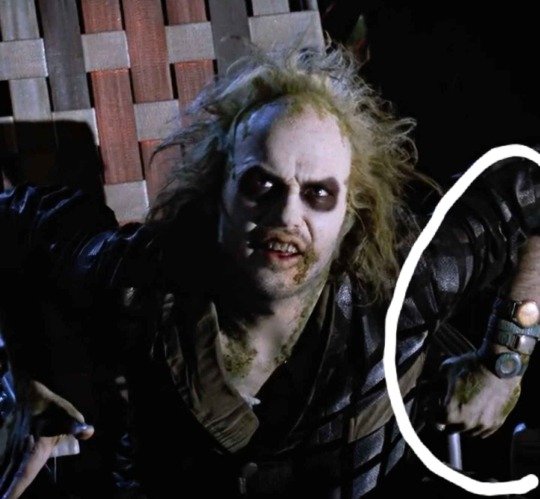
Albedo (White Stage): Before Lydia summons Betelgeuse and agrees to the marriage, he is wearing a black and white suit. White is added to the mix. Purification.

Rubedo (Red Stage): Lydia is manifested a red wedding dress to finish the ceremony. They completed the alchemical process. Lead is turned into Gold.
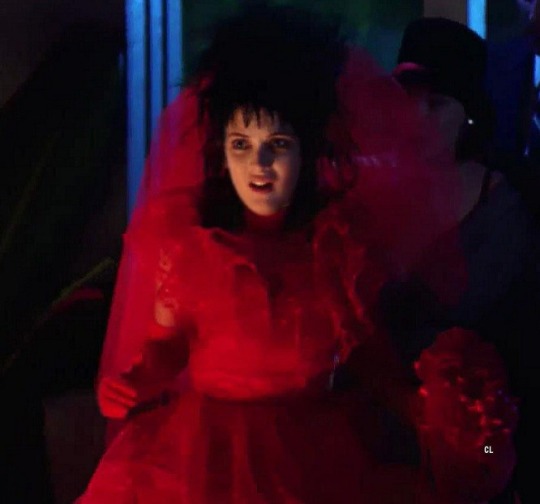
In the movie's original wedding scene, found here, at 9:11 on the clock the afterlife creature who marries Lydia and Betelgeuse dissipates into fire, and then the scene ends. 911 in numerology is the number of completion, and is used in occultism to symbolise new beginnings and rebirth.
For this reason, it has been theorised that the wedding vows went through, and the Chemical Wedding was completed.
#beetlejuice#beetlejuice 2#beetlejuice beetlejuice#theories#alchemy#carl jung#numerology#dream analysis#lydia deetz
54 notes
·
View notes
Text
'Tieflings reach adulthood at about the same age as humans but are longer-lived, with the eldest members of the race living to be 150 years old.' - Planar Handbook
Technically, on Toril tieflings explicitly have human lifespans, but hey, you're not obligated to use that. Give your planetouched half-elf lifespans. (If you want).
...
'Tieflings look human (and are roughly the same height and weight as members of that race), except for one or two distinguishing features related to their unusual ancestry. Some examples of these features include small horns, pointed teeth, red eyes, a whiff of brimstone about them, cloven feet, or red skin. No two tieflings look alike. [also feathered shoulders, scales, no reflection, no shadow, skin is hot to the touch, red or blue skin, skin being freezing to the touch, white hair and deer antlers, glowing eyes, iridescent hair, weird magic powers, wings, control over specific animals, cat eyes, more or less than five fingers, and and and...]'
*insert the regularly scheduled bitching about the standardised portrayal of tiefling appearances in recent editions (and frankly, video games; I blame you, David Gaider) here*
#'Are you ever going to shut up about this?' you ask#nO#4e: 'Yeah we're going to narrow down the highly variable planetouched to one variant and force them to be standardised'#'Then add the aasimar and genasi back later but make 'em weird'#*hiss*#...the genasi having glowing lines was cool though#This wouldn't be a problem except GUESS WHAT SETTING THEY USE FOR VIDEO GAMES#So simply ignoring it - which I would like to do - is harder#See also: VtM 5 but the opposite of love really is apathy here#lore stuff#griping.
35 notes
·
View notes
Text
Dnd 5e (source) books for @doodl3 as a thank you for editing for me
Players Handbook Dungeon master's guide Monster Manual Volo's Guide to Monsters Xanathar's Guide To Everything Mordenkainen's Tome of Foes (Tome of Foes was dedicated to dnd artist William O'Connel who passed away during devlopment of the book at the age of 47) Tasha's Cauldron of Everything Fizban's Treasury of Dragons Mordenkainen's Monsters of the Multiverse Bigby Presents Glory of the Giants (please forgive me this was the best one I could find) (also please forgive me for not including the book The Book of Many Things I couldn't find a pdf for it)
Now for the different dnd settings
Sword Coast Adventurer's Guide Guildmasters Guide to Ravnica Eberron -Rising from the Last War Mythic Odysseys of Theros (you're really going to love that one as that introduced Satyr as a playable race) Van Richtens Guide to Ravenloft Astral Adventurer's Guide Boo's Astral Menagerie (if you love space you are going to love the previous 2) (Also sadly I couldn't find a good version for Sigil and the Outlands, Turn of Fortune's Wheel or Morte's Planar Parade :( I tried I really did)
(Enjoy these 3 adventures though) Strixhaven A Curriculum of Chaos Dragonlance - Shadow of the Dragon Queen and Light of Xaryxis (with the third one you need to use Astral Adventurer's Guide and Boo's Astral Menagerie)
thank you so much for editing my book. :) @doodl3
To any other adventurer including you who stumbles upon this please enjoy. May your story go far and wide and your dice rolls be even higher.
7 notes
·
View notes
Text
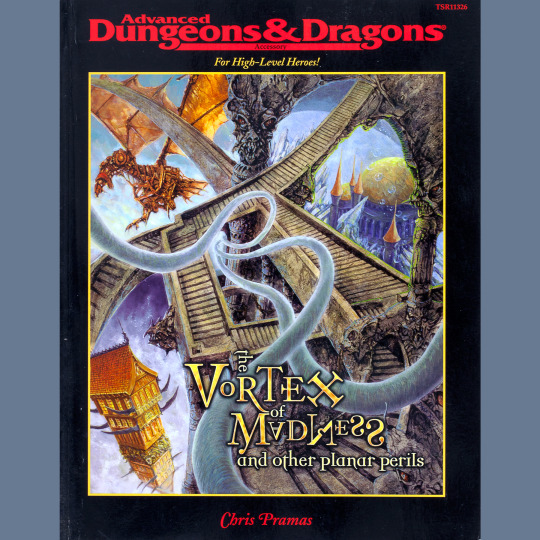
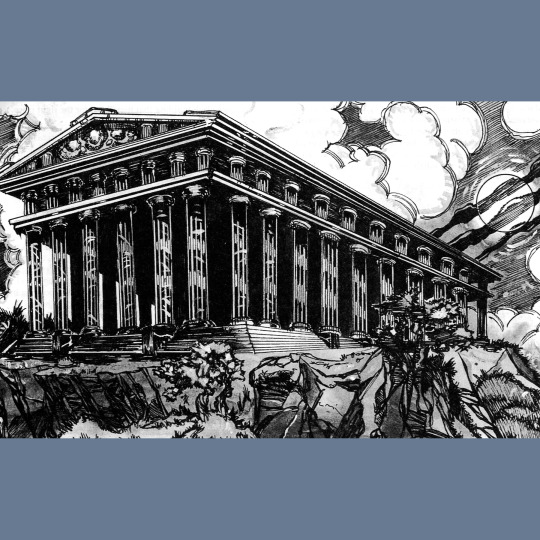
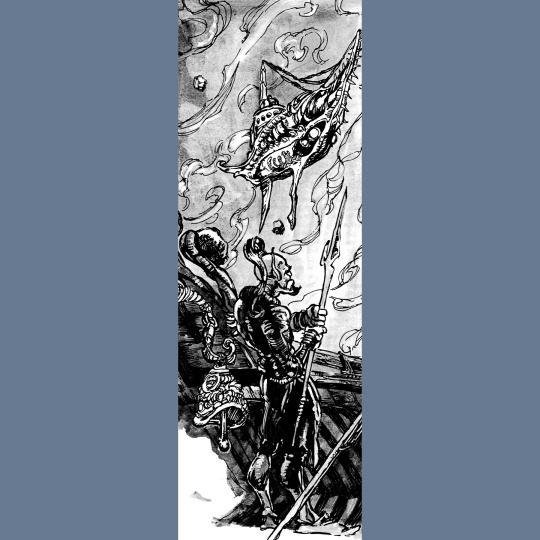
The Vortex of Madness and Other Planar Perils (2000) is the last of the Planescape-esque sourcebooks under the generic D&D banner (itself about to be replaced by 3e). It’s a mixed bag.
The foundation, Chris Pramas’ planar locations, intended as a continuation of the Sites series of sourcebooks (City Sites, Country Sites, Castle Sites) is sound. There’s the titular vortex, the black prison of the Titans of Greek myth, the City of Glass in the Elemental Plane of Water, and the demiplane of invention and a Githyanki citadel in the Astral Plane. All of these are well-realized and interesting. But then there is this linked adventure thread involving the artifacts the Machine of Lum the Mad and the Mighty Servant of Leuk-o. Shannon Appelcline, over in the product listing on Drive-Thru, explains that this was a later addition at the behest of the powers that be, converting a generic location book into an adventure. It’s deeply tortured and even before reading Applecline’s explanation, I could see the pretty clear seems between the good stuff and the stuff I want to pitch in the trash — the adventure thread is mostly delineating in sidebar boxes.
The cover telegraphs it. Dana Knutson’s painting is strange, both evoking elements of Planescape while somehow seeming generic and a bit dull (or uninspired). The stair motif was used twice already (Tales of the Infinite Staircase and The Planewalker’s Handbook), both to better effect. This feels like one final attempt to squeeze the last juice from the planar fruit.
59 notes
·
View notes
Text




After limited entries covering the topic in The Dragon #8, Player's Handbook, and Deities & Demigods, TSR finally greatly expanded on AD&D's planar cosmology (or "alternate levels of reality") with 1987's Manual of the Planes by Jeff Grubb. "This book describes the inhabitants, rulers, and environments of these worlds, as well as rules for movement, survival, combat, and spell use in these alien surroundings." A special callout to Jeff Easley for that fantastic cover art of an astral dreadnought! Nothing plane about it… on THAC0 Thursday!!
#thac0 thursday#thaco thursday#d&d#dnd#ad&d#adnd#advanced dungeons & dragons#rpg#ttrpg#TSR#fantasy#worldbuilding
4 notes
·
View notes
Text
been thinking about extraplanar travel in ttrpgs and what I particularly like about Planescape (at least from reading a lot of the Planeswalkers Handbook), it's mostly about it making a story from the journey as much as what happens at the destinations, like don't get me wrong the cool freaky locations are great, but the fact that specific locations only connect to specific other locations
it's the to get from point A to point B, you have to go a circuitous route via points C and D, and at several points on that trip if something goes wrong you might have to take a detour to points E, F, or G, depending on quite where on the route you made the mistake and all those locations are cool places and there's going to be stuff to do on that route
and sure Planescape is that way because it's ADnD2e, and random encounters and emergent storytelling is the big thing, but I don't see that in other ttrpg planar cosmologies
2 notes
·
View notes
Text

📚 𝘽𝙤𝙤𝙠𝙠𝙚𝙚𝙥𝙚𝙧 | 𝙏𝙧𝙖𝙫𝙚𝙡𝙞𝙣𝙜 𝙈𝙚𝙧𝙘𝙝𝙖𝙣𝙩 📜
A bespectacled human with a well-organized library on wheels. The merchant deals in rare tomes, spell scrolls, and ancient maps. He is a wealth of knowledge and can provide valuable information about the world.
1. The Alchemist's Handbook
2. Folktales from the Western Mountains
3. Map of the Underdark
4. Spell Scroll of Fireball
5. Tome of Ancient Spells
6. Essays on Planar Travel
7. Book of the Dead
8. Chronicle of Ashardalon
9. Grimoire of Elemental Magic
10. Codex of Infinite Worlds
9 notes
·
View notes
Text
Ranger Subclasses in One D&D
A recent playtest document for One D&D featured changes and updates to the Cleric class, including one subclass for the full playtest experience. It got me thinking about what other subclasses we could see in the “One D&D Player’s Handbook,” as Jeremy Crawford has revealed that the plan is to have 4 subclasses for each of the 12 base classes. So far, I’ve shared my thoughts on the Bard and Cleric subclasses.
As with my previous thoughts, I think the main subclasses we will first see in One D&D will strive to offer different playstyles for each class.
Let’s take a look at the Ranger class. So far in fifth edition, there were 2 subclasses in the Player’s Handbook (PHB), 3 subclasses in Xanathar’s Guide to Everything (XGE), and 2 subclasses in Tasha’s Cauldron of Everything (TCE). In the Expert playtest document, the Hunter subclass was given as the first of the four. After looking through the list, I think we will see the Beast Master archetype from the PHB (including revisions from TCE) and the Gloom Stalker and Horizon Walker archetypes from XGE. Below the line, I’ll share why I would pick those three over the other options.

Beast Master
Throughout 5th Edition, Rangers came in two different primary varieties: the wanderer / protector who has traveled through a different realm OR someone who has found connection with one kind of monstrous group. The Hunter is the initial example for the wanderer, one who explores the natural areas of the material plane. The Beast Master is one of the prime examples of the second variety: a friend to the beasts of those same wild places.
The initial version of the Beast Master in the PHB was pretty good; the updates from TCE made the Beast Master even better. The Primal Companion is a superior option as it can level up alongside your character. And with the general tendency towards customization in 5th Edition, you can flavor the Primal Companion as whatever beast you might need (Land, Sea, and Sky).
Gloom Stalker
To get the obvious out of the way: the Gloom Stalker is often quoted as being the best Ranger subclass currently released in 5th Edition. The Dread Ambusher ability alone is one the primary reasons you see the powerful Gloom Stalker Ranger + Rogue multiclass.
The Gloom Stalker fits into the wanderer variety of Rangers, as they are expert explorers of the hidden and dark areas of the world. Most campaigns will find themselves at one point or another within the dark heart of an ancient forest, the sewers and undercity of a sprawling metropolis, or a maze-like catacomb. Gloom Stalker rangers are the perfect fit for any campaign, and so having it as a player option right off the bat would be the most beneficial.
Horizon Walker
Coming out alongside the Gloom Stalker in XGE, the Horizon Walker is another solid subclass pick. While the ability to detect portals isn’t largely useful for most of a campaign, the other abilities make up for it. Planar Warrior adds Force damage to your attacks, which holds the unique position of being the only damage type that no monsters have resistance of immunity to. And I’m a sucker for Misty Step.
Horizon Walkers also fit into the archetype of protectors against malevolent beings from beyond this world, whether that be Fey, Fiend, or Celestial. They are explorers of the wider multiverse, which is an area ripe for great character backgrounds. What are your thoughts?

What three subclasses would you pick for the initial release of One D&D?
3 notes
·
View notes
Text
hmmm
so we have confirmation that the harmonious choir boss, but more importantly the new planar ornaments, are ONLY available in divergent universe. there isnt a new simulated universe world with the choir and the new planar set.
im kind of curious about the future of the SU. will there even be any point in still having the SU when the DU is much more convenient and deep? granted the DU will be located in penacony on the new map rather than the HSS (or rather im pretty sure thats what they said in the livestream and hoyoverse posts). also whats the new ui in the handbook gonna look like? is the DU going to replace the SU tab since su is basically pointless now besides SD and GG?
what an uncertain future. woof
0 notes
Text
New Release Pathfinder RPG - Pathfinder Companion: Plane-Hopper's Handbook Paizo Inc.
Add Another Dimension!
Step beyond reality as we know it! Pathfinder Player Companion: Plane-Hopper's Handbook offers new tools for explorers brave enough to venture into the unknown--whether to abandoned cities created by dead gods, worlds where the ground is made of forsaken souls, or even stranger realms. Add planar allies, magic, or heritage to your adventures and infuse them with the power of the planes!
0 notes
Text
Density Calculator - The density can be calculated quite easily

What is the purpose of calculating Density or specific gravity?
There are many applications where Density is crucial. One of the most important is determining whether a substance will float on another. Less dense substances will float over more dense ones. The following examples illustrate how this applies to everyday life:
Air becomes less dense as it becomes progressively heated until the balloon's Density becomes smaller and smaller until it floats on colder, denser air. This is why hot air balloons rise higher and higher using
Have you noticed warmer water at the surface of a lake or ocean and colder water at the bottom? This is caused by the warmer water being slightly less dense and floating above the denser, colder water. The floating boat must have a density of less than 1 g/cm3 because it weighs so much, but it is also floating, so that's why volcanoes erupt.
What is the procedure for Calculate Density?
The Kernel Density tool in ArcGIS Pro uses an algorithm to calculate density values. The distances are measured using the geodesic method if the input features are points and the planar method if the input features are lines, and use Allcalculator.net. For Kernel Density, divide the default value by 4 to determine the cell size.
While the Kernel Density tool produces a raster output, ArcGIS Online analysis tools generate vector outputs. The Calculate Density tool converts the raster to polygons by using the Reclassify and Raster to Polygon geoprocessing tools before showing the results in Map Viewer Classic.
Density Overview: what is it?
The mass per unit volume of a substance determines its density. Density is more precisely defined as the volumetric mass density, also called the specific mass density. Density is normally represented by the symbol using although sometimes the Latin letter can also be considered.
1 gram of water equals one cubic centimeter
Approximately 5.51 grams per cubic centimeter is the Density of the earth
A cubic meter of air contains 1.2 kilograms of Density.
Our density calculator allows you to calculate the densities of common solids, liquids, and gases within a fraction of a second. In addition, textbooks and handbooks list some of the densities listed.
How are density measurements made?
Archimedes of Syracuse proposed that an object will be measured lighter than its actual weight if submerged in a liquid and then weighed by the weight of the liquid it displaces in his book On Floating Bodies. According to legend, Archimedes used this idea to demonstrate that a crown was not entirely gold but rather a mixture of gold and silver.
A force pushing up on the object, called the buoyant force, causes it to appear lighter in the liquid. As a result, the pressure at the bottom of an object is higher than the pressure at its top since the pressure in a liquid increases with depth with The difference in upward pressures and downward pressures produces the buoyant force.
An object is pushed upward by buoyancy against gravity, which pulls it down. The object will sink if its buoyancy force is less than its gravity force, but it will seem to weigh less in the liquid than in the air if its buoyancy force is greater. Objects that float above the surface of a liquid will float if their buoyancy force exceeds their gravity force.
Density from displacement volume: how do you calculate it?
To measure Density, you can place an object in a liquid and measure how much liquid is displaced by the object. For example, if a small object fits into a graduated cylinder, you can use it to determine by if it is made of lead or a lesser dense metal. To perform this test, find a graduated cylinder with a diameter less than the objects. Use a suitable balance to determine the weight of the object.
Using a graduated cylinder, add water, record the initial volume, and then submerge the object completely in the water, taking care not to create bubbles. In the graduated cylinder, the object's volume is equal to the difference in the object's volume compared with its initial volume, and its Density is equal to its mass divided by its volume.
0 notes
Text
coffee is rare in Belobog according to Lavonne in her version of the daily quest "Grinding in the Dark" ....

in a readable ("Remnants of a Barista's Handbook") the author writes that she makes coffee at the cafe she works at. you get the readable from the Backwater Pass, a more affluent area, so this makes sense if it's rare.
from the flavor text for the planar ornament set "Belobog of the Architects",

coffee plants are tropical. so after the Eternal Freeze, the only way to keep coffee would mean investing in growing a lot of them in greenhouses, which would take up precious space better suited to more substantial foods. coffee is a luxury, so, yeah, a lot of Belobogians probably have never even seen coffee in their lives. it wouldn't surprise me if Gepard, even being a Landau, isn't familiar with it and doesn't like it, ahaha
Does Belobog people don't know what coffee is?
Since Gepard call it as a brown drink. He also doesn't like it. Either it's because Himeko is the one that makes them or he just don't like the bitterness of it. (Gepard sweet tooth headcanon real?)
Well that's another point for Gepard being cute.
#very cute point for gepard honestly#sorry i didn't mean to infodump on your post but i had been thinking about this recently haha#hsr#gepard landau
15 notes
·
View notes
Text
D&D Worldbuilding: Planar Cosmology
When designing a cosmology, the primary goal is to explain the rules of physics that will affect the players, or at least affect their understanding of the game setting on a larger scale. You can always go with a traditional D&D model like the Great Wheel, World Tree, or World Axis if you don’t want to bother with creating one, or the players might simply not have knowledge of planes other than the Material Plane. Heck, maybe they don’t exist! But if you DO want to create a cosmology, make sure you think about the things that will matter to your campaign.
Your cosmology might depend on the story you want to tell. If you plan to have the players travel to other planets, you'll need to map them out. If you plan to have players hopping from plane to plane, you will need to explain how they affect one another and how they connect and how they are different. If your campaign takes place in an unusual world very different from our own, you might need to explain what those differences are and what causes them.
To start with, I would first determine what sorts of planes exist in your world. There can be many, even infinite, or just a few or a couple of planes. Once you have those, you can arrange them and determine how they interact. A lot of this stuff is picked up from the 3e Manual of the Planes, with some new ideas added.
Planar Traits
For each plane, you should determine its traits as they would affect the players and the other inhabitants of the plane. When you make these decisions, you should always consider how they will affect the inhabitants; how they evolve, how they act, and how they advance technology to make their lives easier.

Planar Shape: This is honestly my favorite part of creating a plane. It can lead to truly memorable and unique planes. Remember Sigil? Of course you do. It's a city lining the inside of a donut. Imagine a whole plane shaped like that and how interesting it would be as a campaign setting. To help brainstorm this, look around you and imagine how ordinary objects would look like as a plane and how it would affect creatures within.
Infinite: Extends infinitely in all directions. Could be an infinitely flat planet, an infinite sea, an infinite space filled with planets, an infinite underground maze, you name it. The plane could even be a self-contained shape, like a rectangular prism where it extends infinitely in two opposite directions. I once had a world that was an infinitely tall cylinder, forcing the entire plane to become one tall city that crumbled into ruins the deeper down you went.
Finite: This plane has a beginning and it has an end. What happens at the ends of the plane is up to you. There could be a physical wall, a magical barrier, nothing, or a way to another plane. Perhaps the plane is surrounded by one or more planes, like how Vatican City is its own country inside of Italy.
Self-Contained: This plane loops back on itself or otherwise contains itself. Examples:
A sphere: either on the inside or outside of the sphere.
A prism: either on the inside or outside of a geometric shape like a box, pyramid, or in an ironic twist, an icosohedron.
A torus: like the city of Sigil.
Layered: Like many of the Outer Planes. The individual layers of a layered plane could be infinite, finite, or self-contained. Usually, there is some way to travel between the layers, even for non-spellcasters.
Anything Else: Your plane could ride on the back of a tortoise through an infinite sea, or be branches of a world tree, or an infinitely rolled-up map scroll of a deity, or an astral cornucopia that spirals infinitely in and out. Anything you can imagine can be a planar shape. Get creative!
Gravity: Honestly I wouldn't fool around with gravity too much, but it can be exciting during multiplanar adventures to visit a plane with unique gravity.
Normal: Your average everyday Earth gravity.
Heavy: Creatures can't jump as high and might potentially move slower. Falls deal more damage.
Light: Creatures can jump higher and take longer to reach the ground. Falls deal less damage.
None: Creatures float aimlessly and must find some unusual form of locomotion to be able to move.
Objective Directional: Gravity pulls wherever you happen to stand, allowing you to walk on all six sides of a floating cube, for instance.
Subjective Directional: Gravity pulls wherever you intentionally decide where it should pull. Gravity can be used to effectively fly once you get the hang of it.
Mutability: A less-useful trait that I was introduced to from 3rd edition that describes how easy it is for the plane to be altered by creatures and deities. This was mostly an excuse for deities to stay in the Outer Planes of the Great Wheel, but can be useful for some interesting campaigns.
Alterable Morphic: An alterable morphic plane is relatively normal. The plane is affected by physical force and magic.
Static: A plane that is highly resistant to change. Living creatures remain unaffected by physical or magical force. Moving unattended objects requires a great deal of physical strength.
Highly Morphic: This universe is highly unstable and sensitive to just about everything. Spells, sentient thought, or force of will can alter the plane. Spells might have an enhanced effect, and physical force is far more efficient than a regular plane.
Magically Morphic: Specific spells can alter the material of such a plane. This is how the elemental planes in the Great Wheel Cosmology work, with casters being able to channel the planar elements into their spells.
Divinely Morphic: Deities or similarly powerful creatures can alter the plane easily, changing the landscape with a snap of their fingers. The Outer Planes of the Great Wheel work this way, leading to many deities finding homes there. Non-deities otherwise find it similar to an Alterable Morphic plane.
Sentient: The plane reacts only of its own accord, becoming more or less hospitable depending on its reaction to visitors. For instance, an evil-aligned plane might make it easier for evil-aligned creatures to exist there but become aggressive towards good-aligned travelers.
Time: Time really doesn't matter unless players are travelling between planes with vastly different time streams. Just keep in mind that some planes might have faster or slower time than others. Some may even have an erratic time flow, and still others may be timeless. But while a creature is on a plane, changes in time are normally imperceptible to that creature.
Magic: How does magic work in your world? Usually, you at least want to differentiate between arcane and divine magic somehow, but depending on your world, you might not need to. Here are some ideas. Get creative with this but be as precise as possible as it can make or break a campaign setting.
Magic comes from deities and other similarly powerful creatures. Arcane magic is magic stolen from them.
Magic is drawn from the elemental planes. Deities also channel from these planes and pass it on to disciples.
Magic is drawn from souls. Arcane magicians draw from their own souls or from the souls of others. Divine casters draw magic from their deities, which have powerful souls thanks to worship.
Magic comes from a star at the center of the plane. Some people theorize it will run out after several millennia.
Magic is drawn from the land. Good mages ask for its magic, evil mages simply wrench the magic from the land causing blight.
Magic comes from crystals found deep within the earth, charged by the plane's crystalline mana core.
Magic is drawn from spirits or faeries that inhabit all things.
Magic can only be drawn from the Weave using technology, not force of will.
Magic has its own natural power grid of ley lines, from which spellcasters draw power. It is more powerful in come places but powerless in others.
Magic comes from natural rips in the multiverse that cause other planes to bleed into the Material Plane. Power is drawn from them.
Planar Interaction
Once you have a whole bunch of planes designed, you should figure out how the planes interact with one another. Think about the following:
Do any planar forces spill into connected or nearby planes? For instance:
Elemental energy (fire, water, lightning, etc.)
Emotions (hatred, happiness, love, fear, etc.)
Morality (good/evil/law/chaos, or others)
Matter (water could originate from a water-plane, etc.)
Magical energy (magic from a specific school might come from a plane)
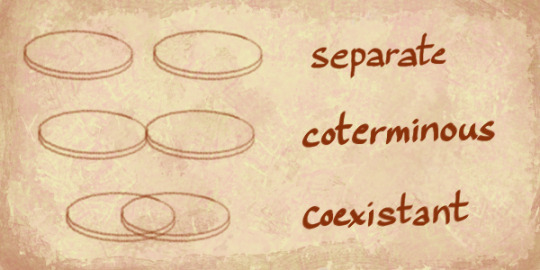
How can players or other entities travel between planes? For each pair of planes are they:
Separate Planes: planes are completely separate and cannot be bridged except by maybe a tertiary plane.
Coterminous Planes: planes touch at at least one point and can be crossed at those intersections through some sort of portal or bridge. Planar travel spells might need to be cast at the appropriate location.
Coexistent Planes: planes are layered on top of one another. Appropriate spells can shift you from one plane into the other at any given point. The Ethereal plane is traditionally a plane coexistent with the material plane.
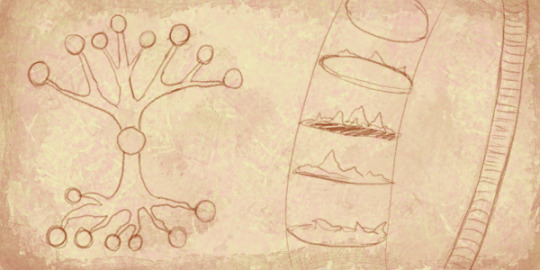
How are the planes arranged? This is very open-ended and can range from the metaphorical to the literal to the mythological. One way of brainstorming a unique configuration is by taking the planes in different shapes and physically arranging them into unique formations. Here are a few examples:
The Great Wheel: The traditional D&D 3.5e setting where the Material Plane is surrounded by all other planes with each in turn affecting it. The inner planes of the wheel are elemental in nature, which the outer planes are based on their alignment.
The World Axis: The post-spellplague D&D 4e setting places the Material Plane beside two parallel planes, the Shadowfell and Feywild, that form an axis. On one side of the axis is the Astral Sea and on the other side is the Elemental Chaos. Other planes are interspersed throughout without much other reason.
The World Tree: The pre-spellplague Material Plane from D&D was the trunk of a great tree where the upper branches held the good-aligned planes and the roots contained the evil-aligned ones.
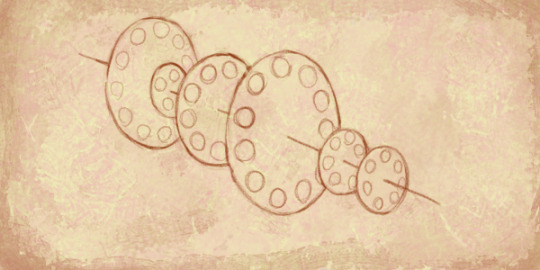
The Great Clock: Imagine a cosmology where there are several wheels of planes spinning along the same axis. Each has different sizes and spins at different speeds, leading to some planes becoming coterminous at varying times, leading to seasonal cycles and regular power fluctuations.
The Planar Sea: All planes are separate and don't interact with one another. Breaching beyond one plane's outer limit either through magic or force leads to an infinite sea of unknown liquid, through which other planes can be reached.
The Planar Web: There is a moderate order to the planes, which are connected by planar strands to one another in a great web. Some planes have many connections to one another, some do not directly connect to each other, and some might be unreachable with no strands connecting them. Powerful magic can create or destroy these strands.
Planar Ring/Loop: All planes are coexistent, layered on top of one another, but each is only reachable by first traveling through the planes in a specific order. There are a set number of planes in this way and their order loops back on itself, creating the illusion of a ring.

Example: Coin World
Here's an example of a main setting paired with a generic cosmology.
Planar Shape: The plane is flat like a coin expanding infinitely in all directions. Life exists on both sides of said coin. There is about three miles of earth separating both layers, but some tunnels do exist linking the two sides. Many creatures on both sides are completely unaware of the other side's existence.
Gravity: Gravity always points towards a face of the coin-shaped plane. This does lead to creatures halfway between both planes floating in midair between the two faces without requisite force.
Mutability: The plane is Alterably Morphic; normal mutability.
Magic: All magic comes from written words or drawn symbols. The size/complexity of the symbol affects the spell's effect. A simple notion of intent causes a spell to occur. This is added as a component to all cast spells. A sorcerer might be born with a symbol on their body somehow. A warlock has a brand of their patron drawn onto them. Divine casters do not have to know the symbols of magic like a wizard does as their deity draws the symbol for them.
Time: Time moves normally on the prime plane, but slower the further away from the prime plane that you travel.
Cosmology: Planes extend infinitely away from the prime plane in metaphorical layers, with time slowing down the further away from the prime plane you travel. Deities on the distant planes see millennia pass by in moments. Planes and deities on one side of the prime plane can only affect the side of the prime plane that they face. The infinite planes on one side tend more towards good and on the other tend more towards evil, but there is no gradation. Law and chaos are ideals imposed by mortals and have no specifically-aligned planes.
Planar Travel: The planes are coterminous with adjacent planes, meaning that one must travel between each plane in turn if they wish to reach a plane several layers away. Travel can only be facilitated through magical means, but still can only travel as far as one plane away with one casting.
Affectations: The good and evil sides of the prime plane are affected by the residual emotions of their outer planes, making creatures on the good side tend towards good and on the other side tend towards evil, though this is not exclusive as alignments vary on both sides.
#D&D#worldbuilding#Dungeons and Dragons#Noblecrumpet#Dorkvision#DnD#D&D 5e#DnD 5e#planes#multiverse#planar handbook#manual of the planes#cosmology#cosmos
1K notes
·
View notes
Text
Wizard Spells
Cantrips: Acid Splash, Blade Ward, Chill Touch, Dancing Lights, Fire Bolt, Friends, Light, Mage Hand, Mending, Message, Minor Illusion, Poison Spray, Prestidigitation, Ray of Frost, Shocking Grasp and True Strike
1st level spells: Alarm, Burning Hands, Charm Person, Chromatic Orb, Color Spray, Comprehend Languages, Detect Magic, Disguise Self, Expeditious Retreat, False Life, Feather Fall, Find Familiar, Fog Cloud, Grease, Identify, Illusory Script, Jump, Longstrider, Mage Armor, Magic Missile, Protection from Evil and Good, Ray of Sickness, Shield, Silent Image, Sleep, Tasha's Hideous Laughter, Tenser's Floating Disk, Thunderwave, Unseen Servant and Witch Bolt.
2nd level spells: Alter Self, Arcane Lock, Blindness/Deafness, Blur, Cloud of Daggers, Continual Flame, Crown of Madness, Darkness, Darkvision, Detect Thoughts, Enlarge/Reduce, Flaming Sphere, Gentle Repose, Gust of Wind, Hold Person, Invisibility, Knock Levitate, Locate Object, Magic Mouth, Magic Weapon, Melf's Acid Arrow, Mirror Image, Misty Step, Nystul's Magic Aura, Phantasmal Force, Ray of Enfeeblement, Rope Trick, Scorching Ray, See Invisibility, Shatter, Spider Climb, Suggestion and Web
3rd level spells: Animate Dead, Bestow Curse, Blink, Clairvoyance, Counterspell, Dispel Magic, Fear, Feign Death, Fireball, Fly, Gaseous Form, Glyph of Warding, Haste, Hypnotic Pattern, Leomund's Tiny Hut, Lightning Bolt, Magic Circle, Major Image, Nondetection, Phantom Steed, Protection from Energy, Remove Curse, Sending, Sleet Storm, Slow, Stinking Cloud, Tongues, Vampiric Touch and Water Breathing
4th level spells: Arcane Eye, Banishment, Blight, Confusion, Conjure Minor Elementals, Control Water, Dimension Door, Evard's Black Tentacles, Fabricate, Fire Shield, Greater Invisibility, Hallucinatory Terrain, Ice Storm, Leomund's Secret Chest, Locate Creature, Mordenkainen's Faithful Hound, Otiluke's Resilient Sphere, Phantasmal Killer, Polymorph, Stone Shape, Stoneskin and Wall of Fire.
5th level spells: Animate Objects, Bigby's Hand, Cloudkill, Cone of Cold, Conjure Elemental, Contact Other Plane, Creation, Dominate Person, Dream, Geas, Hold Monster, Legend Lore, Mislead, Modify Memory, Passwall, Planar Binding, Rary's Telepathic Bond, Scrying, Seeming, Telekinesis, Teleportation Circle, Wall of Force and Wall of Stone.
6th level spells: Arcane Gate, Chain Lightning, Circle of Death, Contingency, Create Undead, Disintegrate, Drawmij's Instant Summons, Eyebite, Flesh to Stone, Globe of Invulnerability, Guards and Wards, Magic Jar, Mass Suggestion, Move Earth, Otiluke's Freezing Sphere, Otto's Irresistable Dance, Programmed Illusion, Sunbeam, True Seeing and Wall of Ice
7th level spells: Delayed Blast Fireball, Etherealness, Finger of Death, Forcecage, Mirage Arcane, Mordenkainen's Magnificent Mansion, Mordenkainen's Sword, Plane Shift, Prismatic Spray, Project Image, Reverse Gravity, Sequester, Simulacrum, Symbol and Teleport
8th level spells: Antimagic Field, Antipathy/Sympathy, Clone, Control Weather, Demiplane, Dominate Monster, Feeblemind, Incendiary Cloud, Maze, Mind Blank, Power Word Stun, Sunburst and Telepathy.
9th level spells: Astral Projection, Foresight, Gate, Imprisonment, Meteor Swarm, Power Word Kill, Prismatic Wall, Shapechange, Time Stop, True Polymorph, Weird and Wish
Source: Player's Handbook
0 notes
Text
Roleplaying Races 6: Aphorite

So far in these race specials, we’ve dealt with several different planetouched, or “planar scion” races. Most of which are born from unions of mortal flesh and otherworldly essence, either in the very explicit way, or simply osmosis of such energies.
However, today we’re looking at a planar scion race that stretches the definition of planar scions as we previously knew it. Unlike aasimar, ganzi, tieflings, or any of the elemental genikin planetouched, today we are looking at a race created by the outsiders they are linked to, rather than being born by natural means, more of their kind being either crafted or born to pairings of this otherworldly race, either with others of their kind or with mortals.
I speak, of course, of the aphorites, a race of beings created by the lawful axiomites to serve as the bridge between their perfectly ordered (and utterly alien to mortals) minds and the flexibility and free will of mortals. Their name shares the same roots as “aphorism” which refers to a concise statement of scientific principle, or an adage with a ring of truth to it.
Indeed, aphorites often either serve as diplomats, often as go-betweens between the mortal realms and the city-plane of Axis, or otherwise living lives that promote order in the world around them. However, as beings with free will, they are capable of forging their own path, even completely rejecting the concept of order, much like other planar scions.
Aphorites were initially almost perfectly uniform in form and function, but free will is an ultimate changing force, and now aphorites can resemble almost any humanoid race. However, all aphorites consistently have golden skin which periodically flickers and sparkles with glittering light, shedding a crystalline dust which they can use as a defense mechanism, but have found other uses for as well. They also possess metallic hair colors when they resemble mammalian races. I imagine this principle extends to the horns or other cranial growths sported by other races.
As strangers that nevertheless delight in order and structure, aphorite culture is typically a blending of the teachings of Axis with whatever society they are raised in, or otherwise adopt as their own. Aphorites actually actively seek to integrate with these civilizations, rather than create their own, seeing themselves as aides for mortal settlements, rather than competitors for resources.
As lawful beings, they typically get along best with other such races like dwarves, whereas the more free-spirited species can tend to grate on their nerves. However, their ability to integrate can lead them to embracing many of the aspects of more chaotic societies, including some of their kin “falling” to chaos, though this less likely to result in terrible doom the way an aasimar falling to evil might.
Aphorites tend to possess highly structured personalities, being very precise and by the book about their approach to dealing with life. However, they are often also possessed by a great wanderlust, perhaps from an instinctive desire to learn as much about mortal societies as possible, so many easily take to the adventuring lifestyle.
Powerful and cunning, aphorites are the very picture of physical might and mental capacity, but their reactions are somewhat stiff.
The average aphorite measures at the same general height and weight as a human, with some variation for those resembling other races. However, as native outsiders, they do enjoy dark-piercing sight.
Hailing from the plane of order as they are, most of their kind is skilled at some craft or another.
They can also use their inherent magic to ward themselves against chaotic foes.
Additionally they are naturally resistant to electricity, poison, and mental effects.
Rounding out their defensive abilities is the ability to shed their crystalline dust at an accelerated rate, filling the air near them in a glittering cloud that occasionally forms glyphs and runes, a callback to their connection to their axiomite creators. This cloud hides their movements, making them more difficult to target.
Of course, there is always some variation, particularly as aphorites diversify from their original uniformity. Some forgo their resilience to attacks on the mind to open themselves with subtle telepathy to allies, sharing information freely when helping them recollect, others dive into the role of ambassadors, learning languages at an accelerated rate, some work with such mechanical precision that they can churn out weapons and armor with great efficiency, keeping their allies well-stocked, and some carry imbedded memories of The Perfect City in their minds, using it as a reference point to understand mortal settlements as well, and tapping into magic to bolster their mobility in such environs.
As a strong and cunning race, aphorite adventurers tend to favor classes that let them make equal use of brains and brawn, such as magi, warpriests, alchemists, investigators, or even occultists. Of course, they can also excel at other classes that makes use of either their body or their mind, but they tend to avoid ranged or agility based builds unless their natural proliclivities are strong enough to make up for their weakness in that regard. Additionally, there are plenty of feats that are exclusive to aphorites, like the ability to get more diverse uses out of their dust, and so on.
26 notes
·
View notes
Text
Backgrounds with Class: Warlock
Some classes and backgrounds mesh naturally, from a conceptual standpoint. Soldier and Fighter, Entertainer and Bard, Sage and Wizard. But backgrounds aren’t class-restricted, and so I wonder what it would look like if you paired every class with every background, even the ones that seem at odds, like Sage and Barbarian, or Outlander and Wizard. So I thought about it, and this is what I came up with. Some character concepts for each class, and each Player’s Handbook background for each class.
Warlock
My watchwords for warlocks are: remember your obligations. Warlocks made an agreement. The benefits are their class features, spells, invocations, and pact boons. Their side of the agreement isn’t mechanically defined, so that’s where most of the character building goes. What did your character’s patron want from them? What did they ask for when the pact was made, or have they not yet asked for something? It could be something relatively minor, or it could be something huge and sweeping that define your character. The other thing to remember with regards to your obligations is that your patron had a plan for you; use your patron’s agenda as a guideline for how to choose your spells and invocations to shape your capabilities.
The Acolyte Warlock owes much to the serpent-fiend that spoke with her one night in the dark. He took the form of a wisp of smoke that writhed and coiled, and put in her mind the doubt about her service to Apsu- the Dragon of Ages had never spoken to her, through her time as a copper initiate, but this fiend has. Since their first conversation, the shadowy serpent has begun feeding her arcane power, in exchange for a handful of favors- some innocuous, others less.
The Charlatan Warlock has always been one to make a deal. So when the opportunity came to ride-along with a mysterious caravan who claimed distinct interest in his cleverly-faked potions, he jumped. A trip across planar borders was a surprise, and his new ‘partner’s noble status among the courts of the marid even moreso. She wasn’t fooled by his potions, of course, but she claimed to have use for a clever-tongued agent…and her watery magic has already proven useful, to evade angry marks.
The Criminal Warlock was a tomb robber, and a good one, until he and his companions accidentally stumbled into a still-occupied tomb complex. Opening the deepest coffin to see the salt-encrusted remains of the mummy stirring within was a heart-stopping experience alone. That the walking corpse slew the rest of his party in moments was almost unsurprising in comparison. Fortunately, he was quick to swear allegiance, and newly arisen the mummy lord agreed to name him servant.
The Entertainer Warlock spent his life in the theater even before his last big play. His glee was monologues, and he had the habit to practice any role, often without pre-reading them. It was this tendency that put into his hands a strange play, that when read drove his fellow actors mad and sent him to a strange city on the edge of a vast lake. There, he accepted the patronage of a robed king, and now travels far and wide to perform where his Majesty wills.
The Folk Hero Warlock was a ranch hand, once. When she rescued a strange horse with a broken leg and turned it loose when it was well, she earned the trust of a unicorn in disguise. Since, her gifts from the pact have given her the powers she needed to keep her town and the unicorn’s grove safe. The time is coming for her to go forth and do good, though, as her patron insists that she journey to see the world.
The Guild Artisan Warlock is trained in a most unusual craft- the makings of life, and the growth and development of living things. Handy with alchemist’s gear to manage the mutagens needed to cultivate her master’s projects, her greater talent is for negotiation. Fortunate, as when a vast aquatic intelligence from deep in the crater of Shattered Arde made itself known, she was able to parley her expertise into a more symbiotic role, and now serves it by way of a series of intricate knotted seaweed pages.
The Hermit Warlock was, until recently, the latest in a long line of Armory Guardians- a single defender and steward, hidden in an isolated vault in the wilderness. Within, hundreds of weapons lie, the Lady’s Blades, tended because they contain a mysterious power all their own. She took one from the vault on the day that she left it in the hands of her successor, a flail, that spoke with her the first time she needed to defend the vault from would-be bandits.
The Noble Warlock is a man in the midst of making himself. After trading his name to a fey lady in exchange for the power of a warlock’s bargain, he’s roamed far and wide seeking a way to reclaim his name- without giving up the power that came with it. Breaking fey bargains is notoriously difficult, though, doubly so for one who refuses to yield the benefits. Cruel and capricious already like the Fair Folk themselves, he’s ready with a sharp word or quick blade for any who speak ill of him.
The Outlander Warlock is a survivor. He grew up on a vast frozen ocean where danger could take many forms and come from any direction. Grandson to the lord of this frozen Hell, making his pact was almost a foregone conclusion, and the benefits well-suited to his charge. Now, he travels far and wide, to distant lands and far-flung waters, to serve his patron’s interests in the endless game of politic he runs from his frozen throne.
The Sage Warlock is a bookish sort, and always has been- his favorites are romances, and tales of fantastic travels and exotic realms. When one night he wandered far off track and into the woods, immersed in his book, he crossed a fey boundary and found himself in the realm of a powerful and elegant fey known only as the Stag Prince. After a night of passion and tale-telling in the Feywild, he returned to the mortal realm with a parting gift from his lover, and the book he bore carried stories it hadn’t previously.
The Sailor Warlock has crewed a funeral barge in Croix Sang since she was young- a family tradition. She and her mother travel the Great Snake collecting the departed that haven’t sold their remains into undead servitude for cremation, collecting their ceremonial two bits from those who see them into her care. One restless spirit was all it took to take her from that life, though, as the ghost of an ancient druid made a pact with her to keep the river and region safe.
The Soldier Warlock was enlisted into the service of an angelic warrior young. She doesn’t mind, though, as being raised in the light and certainty of the ancient guardian’s tutelage was all the encouragement she needed to take up the cause of righteousness. Now, she’s out in the world, baring light, steel, and flame in service of the common good, but learning quickly that things are rarely as cut-and-dried as they are at an angel’s side.
The Urchin Warlock grew up on the crowded streets of Inkshukuq in the Forest of Silence- the air there drips with the humidity of the northern sea. Their living has always been trashpicking, for food and for gold, but when they retrieved the pearl-and-whalebone talisman from one pile, it drew the attention of the sea genie that made it. Intrigued by the prospect of a land-walking servant, a bargain was struck, and now the trashpicker seeks different treasure at their patron’s order.
#D&D#Dungeons & Dragons#Dungeons and Dragons#Character Ideas#Character Designs#Character Concepts#Warlock#D&D Classes#D&D Warlock#Fiend#Archfey#Great Old One#Great One#Hexblade#Celestial#Fathomless#Genie#Backgrounds With Class
241 notes
·
View notes